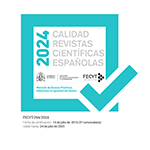El joven Dürrenmatt: Un clásico esquizoide con máscara expresionista. Es steht geschrieben, ópera prima de F. Dürrenmatt. Trasfondo ideológico, temas, motivos y técnicas dramáticas de su obra
Abstract
This work introduces a critical comment on what can be considered as the first published play of the Swiss writer Friedrich Dürrenmatt (1921- 1990). Eve more, it makes a study concerning the ideological background which dominates those thematic and dramatic skills prevailing in his work. The première of Es steht geschrieben at the Schauspielhaus of Zurich in 1946 cuased an uproar among the attendant audience. The play is set in the 16th. century Germany. It relates the historical episode of the Anabaptist sect when they seized the town of Münster and claimed to establish there the Kingdom of the New Jerusalem. Although Dürrenmatt considers his play as a drama, in fact , he puts on stage a burlesque parody with some typical characteristics borrowed from Baroque and Expressionism. In order to achieve such purpose the author uses contrasts and hyperbolic skills in the employed language, the succession of scenes and situations and in the theatrical effects as well. The misuse of power in the name of the Word of God, with its social and political consequences, is both the theological and religious theme of Es steht geschrieben. In this play the expressionist Baroque discloses this Swiss writer as a man who succeeded in combining , in a critical and burlesque way, the western tradition of classical literature with nowadays dramatic and scenic skills and with his own ones:«Einfall», «Zufall» joined to elements taken from the grotesque and the paradox. In this first play Dürrenmatt presents in a new disguise, the inner history of a never-changingmankind: the esquizoid split of personality, the human being’s frustration and failure within a hostile world.Downloads
Article download
License
In order to support the global exchange of knowledge, the journal Revista de Filología Alemana is allowing unrestricted access to its content as from its publication in this electronic edition, and as such it is an open-access journal. The originals published in this journal are the property of the Complutense University of Madrid and any reproduction thereof in full or in part must cite the source. All content is distributed under a Creative Commons Attribution 4.0 use and distribution licence (CC BY 4.0). This circumstance must be expressly stated in these terms where necessary. You can view the summary and the complete legal text of the licence.










